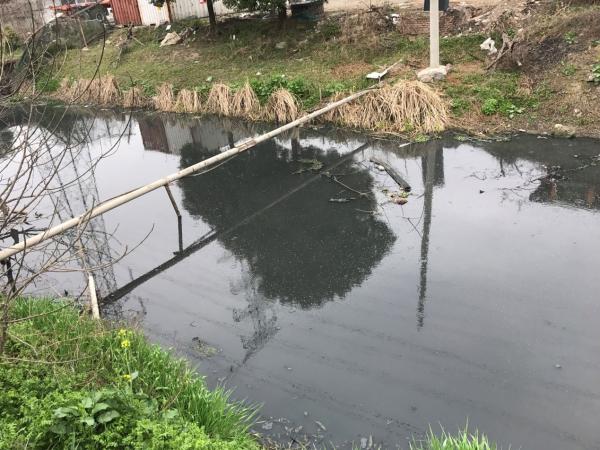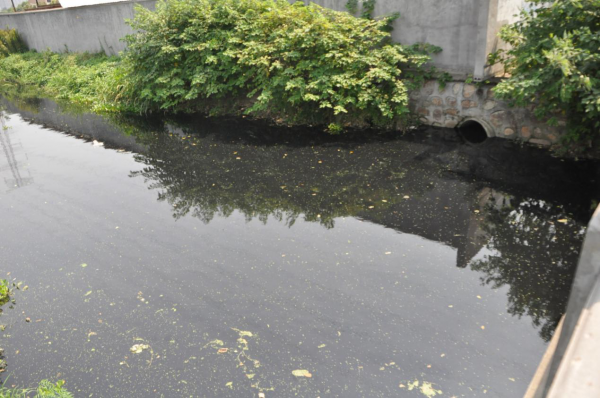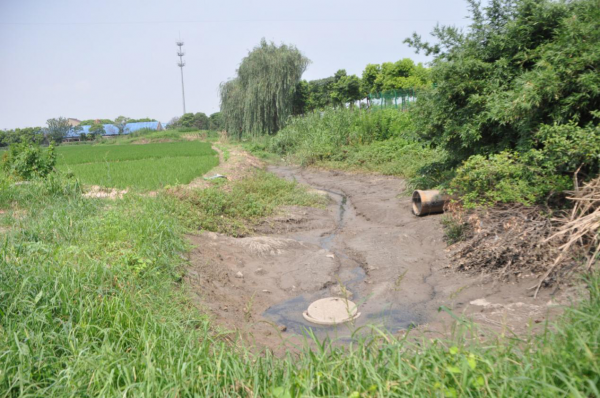
In early March 2017, PECC received a complaint about environmental pollution in Ximaochang Village, which is located at the intersection of Sugang Road and Furong Avenue in Jiangyin City, reflecting that the Henggou River in this area was seriously polluted, and the living environment of the residents was miserable.
On the morning of March 19th, 2017, PECC’s researchers rushed to the area with environmental pollution reported by residents in Ximaochang Village. Led by the local residents, PECC’s researchers found that the Henggou River was as black as ink and had a foul odor. Many bubbles appeared on the water surface from time to time. Even standing on the shore, researchers felt dizzy when they smell the stench. There was an unbreathable stench in the surrounding air. After in-depth investigation, three pollution sources were found in the area.

Figure 1: The polluted river is black and foul

Figure 2: Pollution source 1

Figure 3: The wastewater of the pig farm is discharged directly into the river

Figure 4: Pollution source 3
On March 20th, 2017, PECC submitted the “Research Report on Water Pollution in Ximao Village, Jiangyin City” to Jiangyin Municipal People’s Government, Jiangyin Environmental Protection Bureau, and the Management Committee of Jiangyin Lingang Economic Development Zone.
On March 23rd, 2017, Mayor Cai Yeming of Jiangyin City read out PECC’s “Research Report on Water Pollution in Ximao Village, Jiangyin City” at the first plenary (expanded) meeting of the special action leading group of Jiangyin City’s “Two reductions, Six governance and Three enhancement”, to which Mayor Cai attached great importance and requested the relevant units of Jiangyin City to respond quickly, implement and deal with it as soon as possible.
On March 28th, 2017, the Management Committee of the Development Zone of Lingang District, Jiangyin City issued a remediation plan for the problem of environmental pollution of Nanhenggou River reflected by the environmental welfare organization - PECC.
On April 6th, 2017, invited by Jiangyin Environmental Protection Bureau, PECC came to Jiangyin Environmental Protection Bureau to participate in the on-site research of the water pollution of Nanhenggou River (Nanhenggou River is located in Ximao village) in Jiangyin Lingang Economic Development Zone and the briefing of the remediation of water environment of Nanhenggou River in Ximao Village, Lingang, Jiangyin City.

Figure 5: The briefing of the remediation of water environment of Nanhenggou River in Ximao Village
Chen Fuliang, director of Jiangyin Environmental Protection Bureau, welcomed and supported the supervision of PECC, and thanked PECC for its attention and supervision of Jiangyin’s environmental protection work. Jiangyin Environmental Protection Bureau has always accepted the supervision of PECC with an open mind. Jiangyin Environmental Protection Bureau and all units should check in the real, do in the real, and implement in the real, and find out the pollution source to ensure that the water quality in the area meets the four-class water standard. Through thorough source control and pollution interception, the environmental problems in this area will be completely solved.
The case has entered the rectification stage, and Lingang Development Zone in Jiangyin City is expected to invest more than 12 million yuan for river treatment, farm relocation and reconstruction of sewage network. Jiangyin Environmental Protection Bureau will continue to invite PECC to supervise the treatment process and acceptance of the river.
On July 18th, PECC’s researchers came to the site again to investigate and found that some pollution sources had been cut off. However, the whole section of the river has not been rectified, the color of the river is black and accompanied by a foul odor, and there are still some pollution sources that have not been blocked, and there are still discharge behaviors.

Figure 6: The unblocked pollution source

Figure 7: The intercepted pollution source

Figure 8: The untreated black and odorous water
On September 3th, PECC’s researchers came to the site again to inspect and found that the water pollution at the site had not been thoroughly rectified. In the six parts of the work that Lingang Sub-district is responsible for, apart from closing the farm and isolating the source of pollution, the work of river regulation, silt cleaning, electric irrigation station and rain and sewage diversion has not been fully implemented, and there are no construction workers on site and no other signs of remediation. Although there are aquatic plants such as water hyacinth, the river water near the enterprise is still black and smelly, especially the surrounding enterprises still discharge sewage into the river.

Figure 9: The unblocked pollution source

Figure 10: The unimproved black and odorous water
PECC’s staffs went to Ximaochang Village, Jiangyin City on January 23rd, 2018 to follow up on the following treatment of water pollution. The on-site investigation found that the three pollution sources had disappeared, and the pig breeding plant had been completely closed. There was no trace of the previous breeding plant on the scene. The water quality of the river on the north side of Furong Avenue is still muddy, but the black odor has been improved a lot compared to the previous situation. There are aeration pipes on the surface of the river to improve the water quality. The water quality of the river on the south side of Furong Avenue is basically normal, and the river is still in the process of treatment. The scene is shown in the figures below.

Figure 11: The river channel on the north side of Furong Avenue is under management

Figure 12: The river under management

Figure 13: The farm that has been demolished
PECC will continue to follow up on the management of the river.
The status of the management of the river: under management.
This project is the “Sniper Battle of Water Pollution of Tai Lake” project of the East China Center of SEE.
Thanks to Society of Entrepreneurs and Ecology (SEE) for its financial support. The content and opinions in this article only represent the author’s personal views and have nothing to do with the position or policies of SEE.
